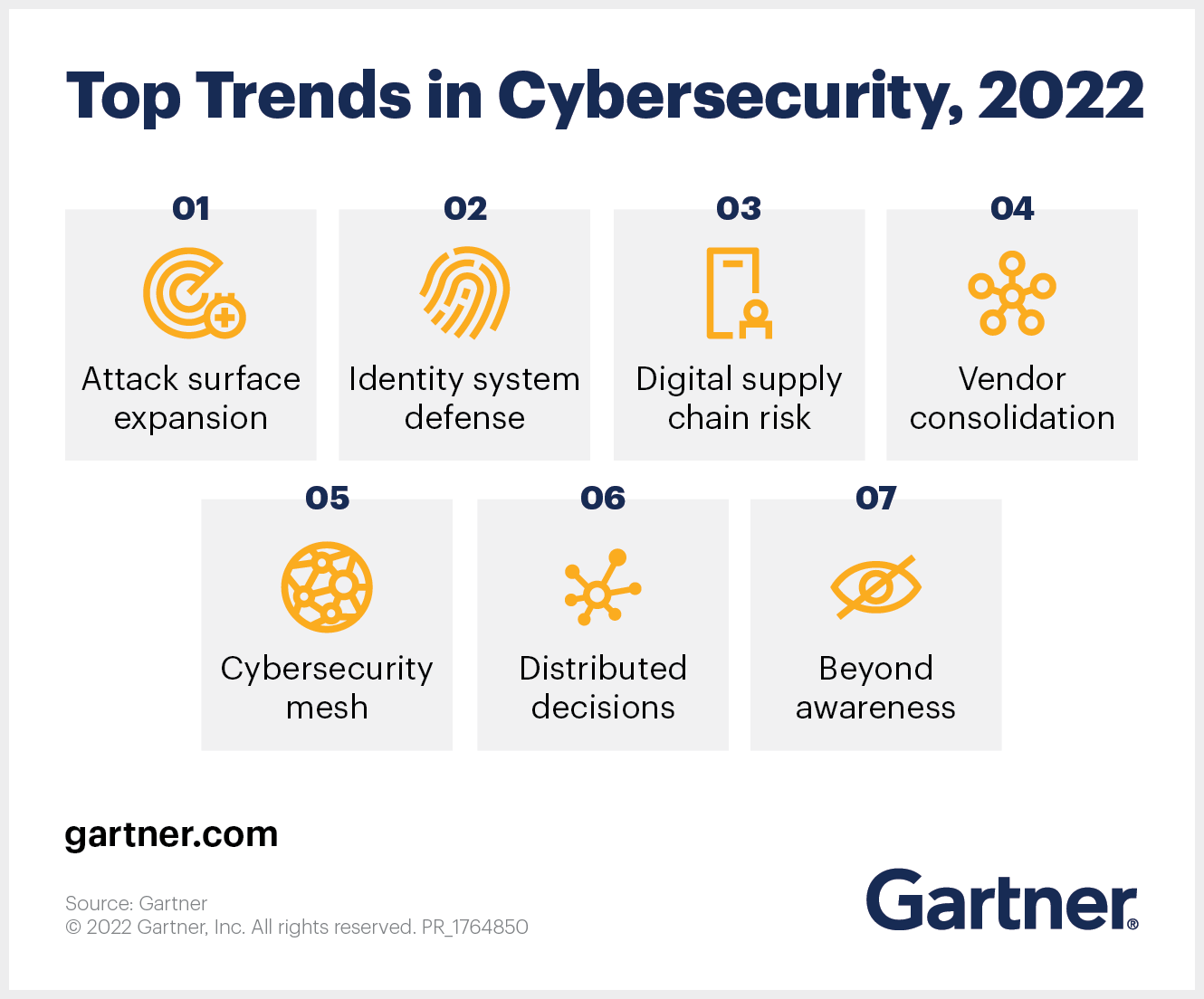The ever-expanding digital footprint of modern organizations drives this year’s top cybersecurity trends.
In short:
- Rethink the security technology stack to address sophisticated new threats.
- Push cybersecurity decision making out to the business units to improve your security posture.
- Evolve and reframe the security practice to better manage cyber risk.
Security and risk executives face a critical juncture, as the digital footprint of organizations expands and centralized cybersecurity control becomes obsolete.
Hybrid work and digital business processes in the cloud have introduced new risks. At the same time, sophisticated ransomware, attacks on the digital supply chain and deeply embedded vulnerabilities have exposed technology gaps and skills shortages.
“These disruptions don’t exist in isolation; they have a compound effect,” says Peter Firstbrook, VP Analyst at Gartner. “To address the risks, CISOs need to transition their roles from technologists who prevent breaches to corporate strategists who manage cyber risk.”
Download now: The Top 3 Strategic Priorities for Security and Risk Management
Those who understand these seven trends will be better able to address new risks and elevate their role, but it requires reframing the security practice and rethinking technology, as well as preparing to respond to new threats.

Trend No. 1: Attack surface expansion
Currently, 60% of knowledge workers are remote, and at least 18% will not return to the office. These changes in the way we work, together with greater use of public cloud, highly connected supply chains and use of cyber-physical systems have exposed new and challenging attack “surfaces.”
This leaves organizations more vulnerable to attack. Gartner recommends security leaders look beyond traditional approaches to security monitoring, detection and response to manage a wider set of risks.
Trend No. 2: Identity system defense
Identity systems are coming under sustained attack. Misuse of credentials is now a primary method that attackers use to access systems and achieve their goals. For example, in the SolarWinds breach attackers used a supplier’s privileged access to infiltrate the target network.
Gartner uses the term identity threat detection and response (ITDR) to describe a collection of tools and processes to defend identity systems. In the longer term, more consolidated solutions will emerge.
Learn more: Your Ultimate Guide to Cybersecurity
Trend No. 3: Digital supply chain risk
Gartner predicts that by 2025, 45% of organizations worldwide will have experienced attacks on their software supply chains, a three-fold increase from 2021.
Security and risk management leaders need to partner with other departments to prioritize digital supply chain risk and put pressure on suppliers to demonstrate security best practices.
Trend No. 4: Vendor consolidation
Security products are converging. Vendors are consolidating security functions into single platforms and introducing pricing and licensing options to make packaged solutions more attractive.
While it may introduce new challenges such as reduced negotiating power and potential single points of failure, Gartner sees consolidation as a welcome trend that should reduce complexity, cut costs and improve efficiency, leading to better overall security.
Trend No. 5: Cybersecurity mesh
The cybersecurity mesh is a modern conceptual approach to security architecture that enables the distributed enterprise to deploy and integrate security to assets, whether they’re on premises, in data centers or in the cloud.
Gartner predicts that by 2024, organizations adopting a cybersecurity mesh architecture will reduce the financial impact of individual security incidents by an average of 90%.
Trend No. 6: Distributed decisions
Executive leaders need a fast and agile cybersecurity function to support digital business priorities. However, as more aspects of the business are digitalized, the job is becoming too big for a centralized CISO role. Leading organizations are building the office of the CISO to enable distributed cyber judgment.
The CISO and the centralized function will continue to set policy, while cybersecurity leaders are placed in different parts of the organization to decentralize security decisions.
Download now: 3 Must-Haves in Your Cybersecurity Incident Response Plan
Trend No. 7: Beyond awareness
Human error continues to feature in most data breaches, showing that traditional approaches to security awareness training are ineffective. Progressive organizations are moving beyond outdated compliance-based awareness campaigns and investing in holistic behavior and culture change programs designed to provoke more secure ways of working.


